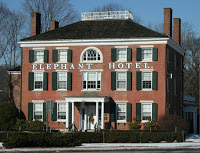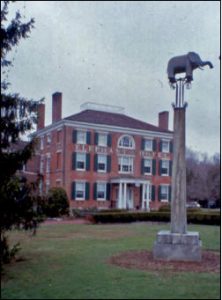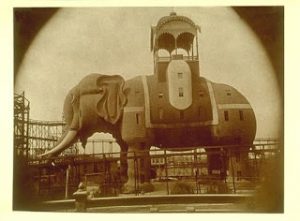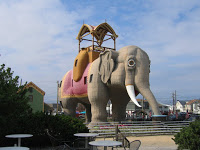Everyone who knows me knows of my interest (obsession?) regarding elephants, an interest that originated during my time living in Kenya. Recently, I’ve become aware of various connections between elephants and hotels.
“What?” you ask. “Elephants and hotels?”
Well, yes.
Here are a few examples.
The first involves Somers, a small town in northern Westchester County, about fifty miles north of New York City. There stands a Georgian brick edifice on which are clearly painted the words “ELEPHANT HOTEL.” In front of this elegant structure stands a column atop which is a statue of, yes, an elephant.
When friends in Somers introduced me to the story of the town’s Elephant Hotel (now the town hall, with the Somers Historical Society and Museum on the third floor), I wondered about the connection between the town and elephants. In fact, I discovered that this can be traced to one Hachaliah Bailey, an early 19th-century resident whose family could trace its presence in the area back to colonial times. Perhaps if you’re good at solving puzzles you may have already noticed a connection between the name Bailey and the subject of elephants, and you’re on the right track. The Bailey of Barnum and Bailey Circus was James Anthony Bailey, a nephew of Hachaliah. At a time when “the circus” is moving definitely into our past with the closing of the Ringling Bros. and Barnum & Bailey Circus in May, it is interesting to look back on the days before formal circuses existed.

Somers, NY
The Elephant Hotel is not named for the species in general but for one very specific elephant, “Old Bet” (originally “Elephant Betty”). Hachaliah Bailey, sometimes referred to as the “first menagerie entrepreneur,” acquired Old Bet sometime in the first decade of the 19th century.

Somers, NY
In the rather convoluted story of Bailey’s work as a menagerie manager, Old Bet became joint property, with ownership rights shared with others. As told in the Somers history: “Sometime in 1815 or early 1816 Hachaliah leased an interest in his menagerie to Nathan Howes of Southeast. On July 24, 1816, while on tour near Alfred, Maine, enroute to Berwick, Old Bet was shot by an angry farmer named Donald Davis who thought it was sinful for poor people to spend their hard-earned cash to see a wicked beast.” The elephant’s death was a great blow to menagerie followers (apparently a great entertainment business in many parts of the United States). Indeed, Old Bet was eulogized in such papers as the Boston Gazette and the New York Herald, and even an advertisement about a display of her skeleton in New York City appeared in the New York Evening Post.
And Old Bet wasn’t forgotten by Hachaliah Bailey, either, for by 1820 he had begun the construction of his new large hotel (his new business venture), destined to become a popular stopping-off point for travelers. The Elephant Hotel opened in 1825, and Bailey erected the statue (later restored) in front of the hotel.

1885
But Somers wasn’t the only site of an elephant hotel. In fact, some hotels owners chose not simply to name their hotel after the elephant, but to make the hotel in the shape of the eponymous animal. I can’t help but wonder if there wasn’t something about the 19th century imagination that drew hotel operators (and their clients) to the “idea” of the elephant. One of the most famous — as described by Marcia Reiss in Lost New York — was “Coney Island’s Elephantine Colossus,” built in 1885.
How I would have loved to have seen this one! At twelve stories (150 feet to the top of the howdah) and located right on the Atlantic shore, this elephant would have been visible to those traveling by sea to New York, even before they entered New York Harbor. Beginning in 1886 — on entering the harbor — they would have seen the Statue of Liberty, also 150 feet in height without its pedestal. From the viewing platform atop the Coney Island Elephant Hotel, visitors could see all the amusements of Coney Island in one direction and the ocean in the other. There were thirty-four rooms (some descriptions say thirty-one rooms) and it became a popular attraction, if only to look at from a distance. And from our 122-year perspective, you can’t help but wonder at the brashness displayed by J. Mason Kirby, the hotel’s builder, when he said, as noted by Reiss, that the building was the “eighth wonder of the world” and could hold 5,000 people (of course he also claimed that from the observation platform, visitors could see the Grand Canyon).
Another telling of the Elephantine Colossus’s story names the designer and builder as James V. Lafferty, who had earlier built Lucy the Elephant in New Jersey (see below) and then later influenced the building of the now-gone “Light of Asia,” an elephant-shaped building in Cape May, New Jersey. But at Coney Island — whether it was J. Mason Kirby or James V. Lafferty — the Elephantine Colossus was a great sight to see, and attracted many New Yorkers.
Still, despite its great novelty, the structure didn’t last long, and it was gone by 1897. For one thing, pickpockets and prostitutes became an on-going problem, and going into the building became less interesting (for ordinary beach visitors) than just looking at it from a distance. Old Bet may have fallen victim to a crazed farmer with a gun, but the Elephantine Colossus was totally destroyed by fire on September 27, 1896, by which date the building had not been occupied for several years.

Margate, New Jersey
As for Lafferty’s Lucy the Elephant (originally called “Elephant Bazaar”) over in Margate, New Jersey, the six-story building wasn’t a hotel — but we can include it here anyway. It was originally built to promote real estate sales, and interested buyers would climb up to the howdah at the top to view parcels of land on offer. The building later was used as a restaurant, business office, and for other purposes and despite some old postcards calling the building “The Elephant Hotel of Atlantic City,” the actual hotel was in another building, nearby.
Lucy is still there, although about 100 yards away from its original location. A civic campaign to save the structure was taken up in the 1960s and considerable repair work was done, to ensure that the building would be safe. It was designated a National Historic Landmark in 1976.
So there is fun to be had thinking about elephants and hotels. And while they are located all over the world, I like to think about these from our local history.
But I mustn’t conclude this “connection” between elephants and hotels without returning to my beloved African elephants and sharing the story of how some of them were discovered behaving in a very different way in a particular hotel. I could try to tell the story, but it’s best told in this brief video, shared by another good friend (not the Somers folks this time). Scroll down the screen to see the video:
An Entire Herd of Elephants Walks through This Hotel Lobby Every Spring.
[Historical Notes based on Somers — Its People and Places: 1788 – A 200 Year History – 1988, published by the Somers Historical Society in 1989 and Lost New York, by Marcia Reiss (Pavilion Books Group, 2011.]
Leave a Reply